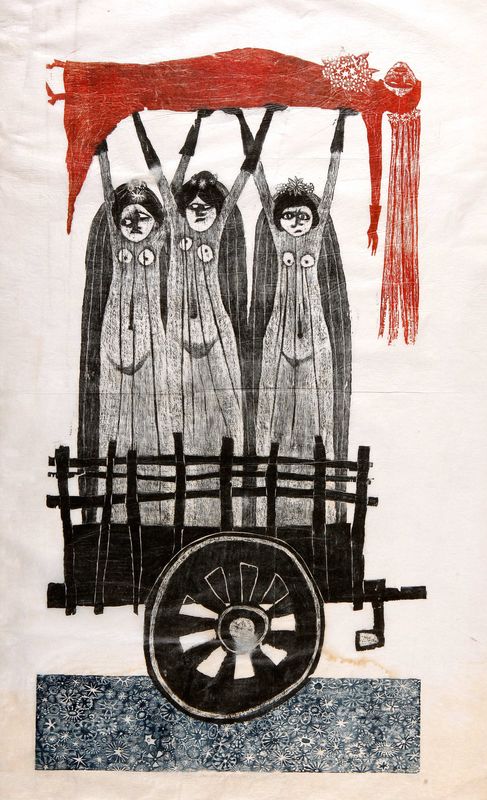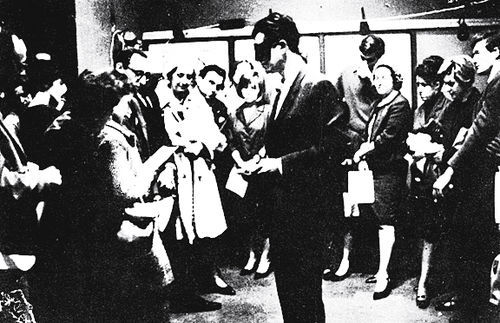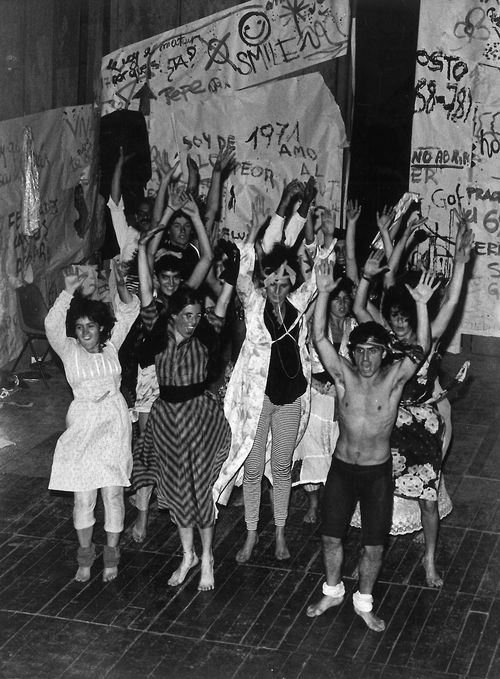Traces in the Shape of History
As works such as the portrait of the unruly Carlota Ferreira made by one of her lovers, the artist Juan Manuel Blanes, attest, women have been represented in Uruguayan art history.# Women artists, however, have not enjoyed much visibility in the canon of that history. Outstanding modern works include, in the Uruguayan planismo movement, paintings by Petrona Viera (1895–1960) and, in the sphere of abstraction, works by Rosa Acle (1916–1990), María Freire (1917–2015), Amalia Nieto (1907–2003), and Olga Piria (1927–2015). The system of representation in the work of the last three was steeped in abstract modernism. While they did not embrace a distinctly feminine or feminist position, they did question that system—which was dominated by male artists—simply by participating in it. Uruguay was, nonetheless, a liberal and forward-looking country when it came to women's rights. Women were given the right to vote there in 1927—before any other country in Latin America—a right they exercised in 1938. In 1942 the country's first four female legislators were elected, and in 1946 they managed to pass a bill that granted men and women equal rights under the law. As Graciela Sapriza points out, those rights were the basis for Uruguayan exceptionality within Latin America, bolstering a myth of equality between men and women there.#
Thanks to growing access to midlevel and higher education, women participated in both the cultural changes and the forms of political intervention—including a politics of the street—that took shape in the 1960s. Guided by a revolutionary ideal, women were drawn to leftist and urban guerrilla movements, trade unions, and political parties. Many women artists took to the street, deploying their very bodies in the cultural scenes of which they formed part and operating within the network of institutions that aspired to the democratization of art. In 1953 the Club de Grabado de Montevideo, a printmaking association, was formed at the initiative of Leonilda González (b. 1923)—who formed part of its board of directors until 1976, when she fled to Peru and then sought exile in Mexico—and of Susana Turiansky (1924–2002).# In 1959 Nancy Bacelo (1931–2002) envisaged a book and print fair, the Feria de Libros y Grabados (1960–2006). Bacelo was also the director of the Galería del Notariado, housed at the association of notary publics, a venue that was able to slip through the grasp of the dictatorship and put forth disruptive proposals. In the late 1960s and early 1970s Teresa Vila (1931–2009) created "thematic environments" or "actions with theme" (fig. 1). At these events Vila would divide participants into groups, cover their eyes, and lead them around as they performed actions in art galleries, in the urban space, and at the Feria de Libros y Grabados. The same groundbreaking spirit was at play in the actions that came before Vila's performances and in the slightly later urban performances by the dancer Graciela Figueroa (b. 1924)# and the actress Adriana Lagomarsino (b. 1943),# held at the Feria del Libro, in Parque Rodó, or in Feria de Tristán Narvaja (figs. 2 and 3).
From the 1960s to the mid-1980s the body was a place of experimentation, resistance, and transgression. The expression "to throw your body into it" was used to refer to experiences such as confronting the police, who would put down protests, and to experiences born of new moral standards in relation to the body, such as free love.# In that era's sensibility, youth, love, revolution, and resistance were enmeshed in the pursuit of a new body freed of classifications and norms.
Contemporary dance played a central role in the crossings that unmarked bodies. The dancer Teresa Trujillo's (b. 1937) experimentation entailed dialogue with film.# In 1964, after a period in New York during which she studied with Martha Graham and José Limón, she went to Paris to take part in intensive experiences across different artistic languages. Along with Mario Handler (b. 1934), who acted as cameraman, she produced Improvisación danza-cine II (Improvisation dance-cinema II, 1964–65), a study in film-dance, while she was living at the Schola Cantorum de Paris. This work involved not simply filming a dance or portraying a dancer but recording—with a camera that also experimented with space—her own experience with the body. Trujillo is the dynamic engine of the work and not its motif. She is at the heart of a construction of white elastic fabric ("the bag") with blotches of black paint, a strange form that covers her body as it slithers like a worm, a structure out of which legs and arms emerge like tentacles. It is the body that sets the form rolling. The camera records the action in changing shots that both follow and stray from her movements.
During the 1960s family models and expectations for women's behavior began to be questioned. From 1968 to 1976 Leonilda González (1923–2017) produced a series of prints of angry and revolutionary brides in the context of the Club de Grabado de Montevideo. Novias revolucionarias (Revolutionary brides) was edition number 176 for 1968, and Novias revolucionarias XII (fig. 4), probably produced the same year, was donated to the Museo de la Solidaridad. The stereotype of the shy and hopeful girl clashes with these images of irascible brides with furrowed brows and breasts visible under their veils. They carry signs that say NO and a coffin; they are crucified or lift up the red body of a dead bride. These are enraged, active women embroiled in struggle who display their sexuality despite modest attire and the mandate of virginity.

In the culture that took shape under the military dictatorship in Uruguay (1973–85), printmaking was much more than a technique. It was a means to disseminate images through monthly publications distributed to members of the Club de Grabado de Montevideo, which formed part of a network of social clubs that included the Foto Club Uruguayo (1940), the Cine Club del Uruguay (1948), the Club de Teatro (1949), and the Teatro El Galpón (1949).# These interrelations contributed to the crossing of artistic languages. If interdisciplinary exchange in Buenos Aires was clustered around the Instituto Torcuato Di Tella, in Montevideo it was activated through clubs that pursued an "independent" culture parallel to the state, a culture expressed in urban spaces. The performative languages of theater and dance seeped into the sphere of the visual arts, affecting the conception of printmaking as well as of installation.
Excerpted from Radical Women: Latin American Art, 1960–1985. Copyright © 2017 by the Armand Hammer Museum of Art and Cultural Center, Inc. Published by DelMonico Books, an imprint of Prestel. The full essay can be found in the exhibition catalogue, available here.
Carlota Ferreira (1838–1912) was neither an artist nor an aristocrat but a rebellious woman who scandalized Uruguayan society with her transgressive morality and her many marriages and affairs. Blanes painted her portrait in 1883.
Graciela Sapriza, "Devenires del feminismo latino-uruguayo," in "Feminismos: La lucha dentro de la lucha," special issue, Contrapunto, no. 5 (2014): 13. Olga Larnaudie, "Club de Grabado y la cultura independiente (1953–1976)," in Club de Grabado de Montevideo (Montevideo: Centro Cultural de España 2011), 115–25.
From 1953 to 1965 Graciela Figueroa was involved in the Dalica group, directed by Elsa Vallarino, and she took classes with Inx Bayerthal and Maxim Koch. She was awarded a Fulbright scholarship at the age of twenty-one, which enabled her to study dance and choreography with the Lucas Hoving Dance Company and Twyla Tharp. She worked on a project with Juan Downey. On returning to Montevideo, she did urban performances at the Feria del Libro and in Parque Rodó. In 1971 she was hired by the Ballet Municipal of Santiago, Chile; she sought asylum at the Uruguayan Embassy in Chile during the coup in 1973. In 1977 she founded the Grupo Coringa in Río de Janeiro, where she lived until 1989. In 1986 she was awarded a Guggenheim Fellowship, and she traveled to New York. Since 1990 she has directed the Espacio de Desarrollo Armónico de Montevideo, engaging in projects in the areas of art, health, therapy, education, and peaceful coexistence. Her works combine the visual and performing arts to address the relationship between the masculine and the feminine.
After being dismissed from her professorship at the Escuela Nacional de Arte Dramático by the military dictatorship, Lagomarsino was exiled in Brazil from 1975 to 1984. Despite being arrested in 1975, she worked intensively in the theater that year. She did street performances and performances on the esplanade of the Teatro Solís in Montevideo. Her performances entailed, for instance, walking down Avenida 18 de Julio in downtown Montevideo dressed in bourgeois attire while taking toilet paper out of her clothes or removing her clothes until she was left in only her bathing suit.
Gabriel Peluffo Linari, interview with the author, July 3, 2014.
Teresa Trujillo with Carina Gobbi, Cuerpo a cuerpo: Reflexiones de una artista (Montevideo: Trilce, 2012).
Gabriel Peluffo Linari, "Club de Grabado in the 'Independent Culture' Crisis (1973–1989)," in Club de Grabado, 133–49.








